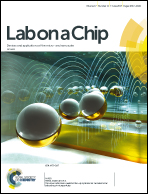Generation and manipulation of hydrogel microcapsules by droplet-based microfluidics for mammalian cell culture
Abstract
Hydrogel microcapsules provide miniaturized and biocompatible niches for three-dimensional (3D) in vitro cell culture. They can be easily generated by droplet-based microfluidics with tunable size, morphology, and biochemical properties. Therefore, microfluidic generation and manipulation of cell-laden microcapsules can be used for 3D cell culture to mimic the in vivo environment towards applications in tissue engineering and high throughput drug screening. In this review of recent advances mainly since 2010, we will first introduce general characteristics of droplet-based microfluidic devices for cell encapsulation with an emphasis on the fluid dynamics of droplet breakup and internal mixing as they directly influence microcapsule's size and structure. We will then discuss two on-chip manipulation strategies: sorting and extraction from oil into aqueous phase, which can be integrated into droplet-based microfluidics and significantly improve the qualities of cell-laden hydrogel microcapsules. Finally, we will review various applications of hydrogel microencapsulation for 3D in vitro culture on cell growth and proliferation, stem cell differentiation, tissue development, and co-culture of different types of cells.

- This article is part of the themed collections: Lab on a Chip Recent Review Articles and RSC papers by NanoEngineering for Medicine and Biology 2018 Speakers


 Please wait while we load your content...
Please wait while we load your content...